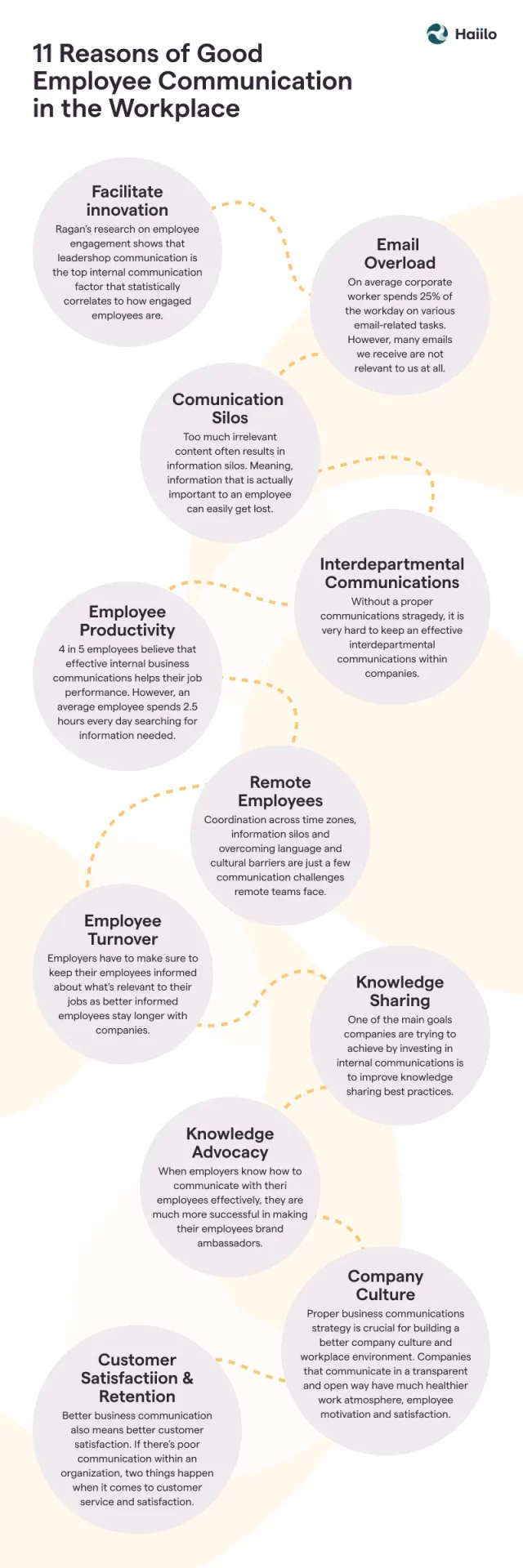What makes a good communication strategy? What are some of the biggest communication barriers, and how to overcome them? These are just a few questions we will be covering in this blog.
The impact of communication on the overall business success is bigger than ever before. It impacts the organization’s reputation, employees’ engagement, and overall business continuity.
📹Check out our Masterclass about how to create a successful internal communications strategy that works for your organization.
What is a Communication Strategy
Simply put, a communication strategy is a plan for delivering a message to your previously identified target audience. Every proper communication plan should clearly identify three crucial factors that directly impact the success of the strategy. These include the audience, the message, and the channels via which the message should be delivered.
However, building and maintaining a successful communication strategy takes much more than that. Later in this blog, we will dig deeper into the set of questions every good communication strategy should answer.
Build a successful communication strategy using our employee communications platform
The Difference Between Internal and External Communication Strategy
There are many different types of communication strategies. However, the most common categorization is by internal communication strategy and external communication strategy.
- Internal communication – information and ideas exchanged within the organization itself. In internal communication messages can be exchanged via personal contact, telephone, e-mail, intranet, or modern employee communication platforms.
- External communication – exchange of information both within the organization and outside the organization. The main goal of external comms is to inform the outside world of an important message about the work and quality of the organization.
📚Related: 12 reasons why internal and external communication go hand in hand.
Why Every Organization Should Have a Clear Communication Strategy?
Organizational communication directly impacts business success. This is particularly true today when people may not be as physically connected as they used to be. Remote work is forcing organizations to adapt to digital means of communication, better leverage asynchronous communication, and make communications departments their most important strategic business partners.
When it comes to external communication, its main goal is to position an organization in a way that’s attractive to the buyer and other stakeholders.

When it comes to external communication, its main goal is to position an organization in a way that’s attractive to the buyer and other stakeholders.
Internal communication, however, can be much more complex and have many different goals such as:
- Improve employee engagement
- Align team members with strategic business goals
- Drive successful change management and digital transformation projects
- Keep employees safe and secure
- Facilitate knowledge sharing
- Reduce employee turnover and much more
To stress the importance of workplace communication, we have prepared for you a few powerful statistics:
- 85% of employees say they’re most motivated when management offers regular updates on company news
- 60% of companies don’t have a long-term strategy for their internal communications
- 74% of employees have the feeling they are missing out on company news
- 87% of people use a mobile phone to communicate at work at least once per week
- Employee productivity increases by 20 to 25% in organizations where employees are connected
- 28% of leaders report poor communication as the primary cause of failing to deliver a project within its original time frame
- Only 23% of executives say that their companies are excellent at aligning employees’ goals with corporate purposes
- 29% of employees say that poor internal business communication is the reason for projects to fail
Furthermore, another survey with executives, managers, and junior staff members found that communication breakdowns in the workplace have multiple downsides. When asked about the consequences of poor communication:
- 52% of respondents said they feel higher stress levels
- 44% said they failed to complete their projects
- 31% said they missed their performance goals
- 20% said that they experience obstacles in innovation
- 18% said that they lost new sales opportunities
📚Read on: Top 5 Communication Skills and How to Improve Them

6 Steps to Create and Manage a Successful Internal Communication Strategy
What are the recommended steps for a successful communication strategy in your organization?
1. Understand your audience
One of the most important prerequisites for every successful communication strategy is identifying and understanding your audience. Only then you can decide about the message, the tone of voice, and the communication channels to be used.
Most workplaces today are dealing with multigenerational workforces. Because of remote and hybrid work, many companies are also multicultural – employees can work from anywhere in the world.
Also, the nature of your employees’ work may significantly impact the way you communicate with them. While corporate workers may be easier to reach, most frontline workers depend on mobile means of communication.
Hence, understanding various audiences is the first and most important step when creating a communication strategy.
📚Read on: Crisis Communication — How to Communicate Effectively with Your Employees
2. Make communication relevant to everyone
Earlier, we saw that many employees have a feeling that they are missing important company information. This is happening because of the extensive information overload employees are facing today.
It is the organization’s responsibility to make information relevant to the audience. They need to be able to reach the right employees at the right time with the right message.
Unfortunately, many organizations still don’t have a way to properly segment their audiences and target the right people with the right message. As a consequence, employees ignore these messages and often miss critical information.
📚Read on: 11 Reasons Why Business Communication is Critical to Your Company’s Success
3. Make information easily accessible while avoiding information overload
The times when people were spending hours finding information are dead. Today, people expect information to find them – in both their private and professional lives.
36% of managers say they’re suffering from poor health due to the excessive amount of information they have to process at work.
Furthermore, 65,2% of UK employees say that their work is negatively impacted by the high amount of data they have to process at work, and 91% of US workers admit that they sometimes delete or discard work-related information without fully reading it!
Having a central place with all the company information is not enough. Organizations are now required to deliver the right information at the right time!

4. Ask for frequent feedback
To make your communication strategy work, you need to involve your employees and encourage their share of voice. Their feedback is the best tool for delivering continuous advancements and keeping high engagement levels.
More than ever before, HR professionals, leaders, and managers are distributing frequent surveys and collecting their people’s thoughts, opinions, concerns, and recommendations for improvement.
It is crucial, however, to act on feedback. The worst thing you can do is ask for feedback and never act on it. This way, you will never be able to build trust in the workplace.
Luckily, there are employee engagement solutions that offer powerful employee insights and provide actionable recommendations for improvements.
📚 Learn about Top Communication Barriers and master the art of communication in today’s digital age.
5. Be data-driven
We have already learned that the business impact of a proper communication strategy can be significant. Yet, many communications professionals still can’t measure and track the success of their campaigns and initiatives.
Every advancement in your organization’s communication strategy should have its goal and purpose. Whether it is to improve employee engagement, increase employee safety, improve productivity, boost employee experience, or reduce turnover, you should tie those initiatives to the ultimate KPIs you are trying to achieve!
📚 Also, check out our recent guide and best practices for team communication!
6. Leverage AI
Artificial intelligence is becoming more and more popular among communications professionals.
In internal communications, AI and machine learning can be leveraged to deliver the right content in front of the right people at the right time, and through the right channel, resulting in a much bigger readership and engagement with future communications.
For example, Haiilo’s social intranet leverages AI to make information search seamless for employees. When employees have a specific work-related question, they get an answer instead of a list of different links and resources to work with.
Next, AI can identify patterns and provide insights from data collected from employee feedback, employee surveys, and other interactions within internal social platforms. This information is valuable for understanding employee sentiment, preferences, and concerns, and can enable employers to better tailor their communications and come up with new employee experience initiatives.
Last but not least, generative AI can help communicators create content 10 times faster!
📹 Take a look at why the dilemma of the blank page is no longer a thing thanks to Haiilo AVA with which internal communicators create content 10x faster!
Communication Strategy Template
Who is your audience, and what are their characteristics?
Think about who you want to target with your message to achieve the biggest possible impact.
- [Persona 1]
- Characteristics such as age, gender, culture, nature of work, and favorite communications channels.
- [Persona 2]
- Characteristics such as age, gender, culture, nature of work, and favorite communications channels.
- [Persona 3]
- Characteristics such as age, gender, culture, nature of work, and favorite communications channels.
What are the purpose and the desired outcomes?
What are you trying to achieve? What is the ultimate goal of this communications campaign/initiative?
- [Objective 1]
- Description objective 1
- [Objective 2]
- Description objective 2
- [Objective 3]
- Description objective 3
How should the message be delivered?
What channels will you be using? Is it social media, is it your company’s intranet, email, newsletter, or some other communications channels?
- [Channel 1]
- Description channel 1
- [Channel 2]
- Description channel 2
- [Channel 3]
- Description channel 3
How will you measure results?
Which metric will you use to measure the results? Is the reach, open rate, response rate, readership, engagement, or something else?
- [KPI 1]
- Description KPI 1
- [KPI 2]
- Description KPI 2
- [KPI 3]
- Description KPI 3










